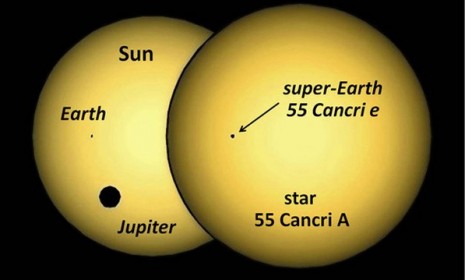The 'exotic' super-Earth that's as dense as lead
Astronomers are thrilled over a nearby world that could promise the most significant breakthrough yet in the study of planetary evolution

Astronomers have spotted an "exotic" planet — a nearby "super-Earth" — that they say is the most solid planet ever discovered, with a density very similar to lead. Here, a guide to this find:
What is a "super-Earth"?
A super-Earth is a planet outside our solar system with a mass higher than Earth's, but lower than our own solar system's large gas planets.
The Week
Escape your echo chamber. Get the facts behind the news, plus analysis from multiple perspectives.

Sign up for The Week's Free Newsletters
From our morning news briefing to a weekly Good News Newsletter, get the best of The Week delivered directly to your inbox.
From our morning news briefing to a weekly Good News Newsletter, get the best of The Week delivered directly to your inbox.
And what is this particular super-Earth?
It's called 55 Cancri e, and is about 40 light years away from Earth. The planet is 13,000 miles in diameter, or 60 percent larger than Earth, but it is eight times as massive. A year on 55 Cancri e lasts just 18 hours, and its sun is bright enough to be seen from Earth without a telescope.
How did scientists spot it?
Since 1997, astronomers had discovered five planets orbiting the star 55 Cancri (the planet 55 Cancri e takes its name from the star it orbits). Last year, two researchers re-analyzed data about 55 Cancri e and concluded that it might revolve around the star faster than originally thought. So they joined up with other scientists and used Canada's MOST space telescope to get more information about the planet.
A free daily email with the biggest news stories of the day – and the best features from TheWeek.com
Do scientists hope to find alien life on 55 Cancri e?
No. The temperature on the surface of the planet could be as high as 4,900 degrees Fahrenheit. "Because of the infernal heat, it's unlikely that 55 Cancri e has an atmosphere," says MIT scientist Josh Winn, as quoted by Space.com. "So this is not the type of place where exobiologists would look for life."
So why is this planet important?
It "could be the most significant breakthrough yet in the study of planet evolution and survival," says the Daily Mail. The brightness of the star 55 Cancri allows incredibly precise and detailed measurements, which makes this super-Earth "the perfect laboratory to test theories of planet formation, evolution and survival," says Winn.
Sources: Daily Mail, International Business Times, Space.com, Space Daily, Vancouver Sun, UPI
-
 Received a gift card this holiday season? Here’s how to maximize it.
Received a gift card this holiday season? Here’s how to maximize it.The Explainer Make the most of your present
-
 ‘Lumpy skin’ protests intensify across France as farmers fight cull
‘Lumpy skin’ protests intensify across France as farmers fight cullIN THE SPOTLIGHT A bovine outbreak coupled with ongoing governmental frustrations is causing major problems for French civil society
-
 The best books of 2025
The best books of 2025The Week Recommends A deep dive into the site of a mass shooting, a new release from the author of ‘Atonement’ and more